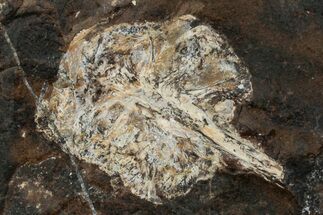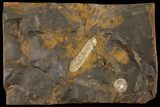This Specimen has been sold.
1.9" Paleocene Fossil Winged Fruit (Acer) - North Dakota
This is a beautiful samara (winged fruit) of the genus Acer sp., collected from the Sentinel Butte Formation of North Dakota. It's associated with a fossil fruit from the Juglandaceae (Walnut) family of the species Cyclocarya brownii. They are finely detailed and the light preservation contrasts well against the dark orangish-brown rock.
An Acer tree can vary in size between small and large, and are typically of temperate regions. Often called "maples", these trees produce drooping clusters of flowers, later forming the distinctive winged fruit that are typically produced in pairs. As seen by this seed, it has separated from its pair.
The Juglandaceae (walnuts, hickories, pecans) has one of the best-documented fossil records in the Northern Hemisphere. The oldest modern genus, Cyclocarya, today restricted to China, first appears in the late Paleocene (57 ma) of North Dakota, USA. Unlike walnuts and pecans that produce edible fruits dispersed by mammals, Cyclocarya fruits are small nutlets surrounded by a prominent circular wing, and are thought to be wind- or water-dispersed. Because Cyclocarya fruits are winged, they might be assumed to be wind-disperse, but their radial symmetry does not have the aerodynamic qualities typical of wind-dispersed fruits, and may have been dispersed by water.
A paper describing these fruits in depth is linked below.
Cyclocarya brownii from the Paleocene of North Dakota, USA
An Acer tree can vary in size between small and large, and are typically of temperate regions. Often called "maples", these trees produce drooping clusters of flowers, later forming the distinctive winged fruit that are typically produced in pairs. As seen by this seed, it has separated from its pair.
The Juglandaceae (walnuts, hickories, pecans) has one of the best-documented fossil records in the Northern Hemisphere. The oldest modern genus, Cyclocarya, today restricted to China, first appears in the late Paleocene (57 ma) of North Dakota, USA. Unlike walnuts and pecans that produce edible fruits dispersed by mammals, Cyclocarya fruits are small nutlets surrounded by a prominent circular wing, and are thought to be wind- or water-dispersed. Because Cyclocarya fruits are winged, they might be assumed to be wind-disperse, but their radial symmetry does not have the aerodynamic qualities typical of wind-dispersed fruits, and may have been dispersed by water.
A paper describing these fruits in depth is linked below.
Cyclocarya brownii from the Paleocene of North Dakota, USA
SPECIES
Acer sp. (winged fruit) & Cyclocarya brownii
AGE
LOCATION
Morton County, North Dakota
FORMATION
Sentinel Butte Formation
SIZE
1.9" long leaf on 7.1x4.7" rock
CATEGORY
ITEM
#95375
We guarantee the authenticity of all of our specimens.
 Reviews
Reviews











